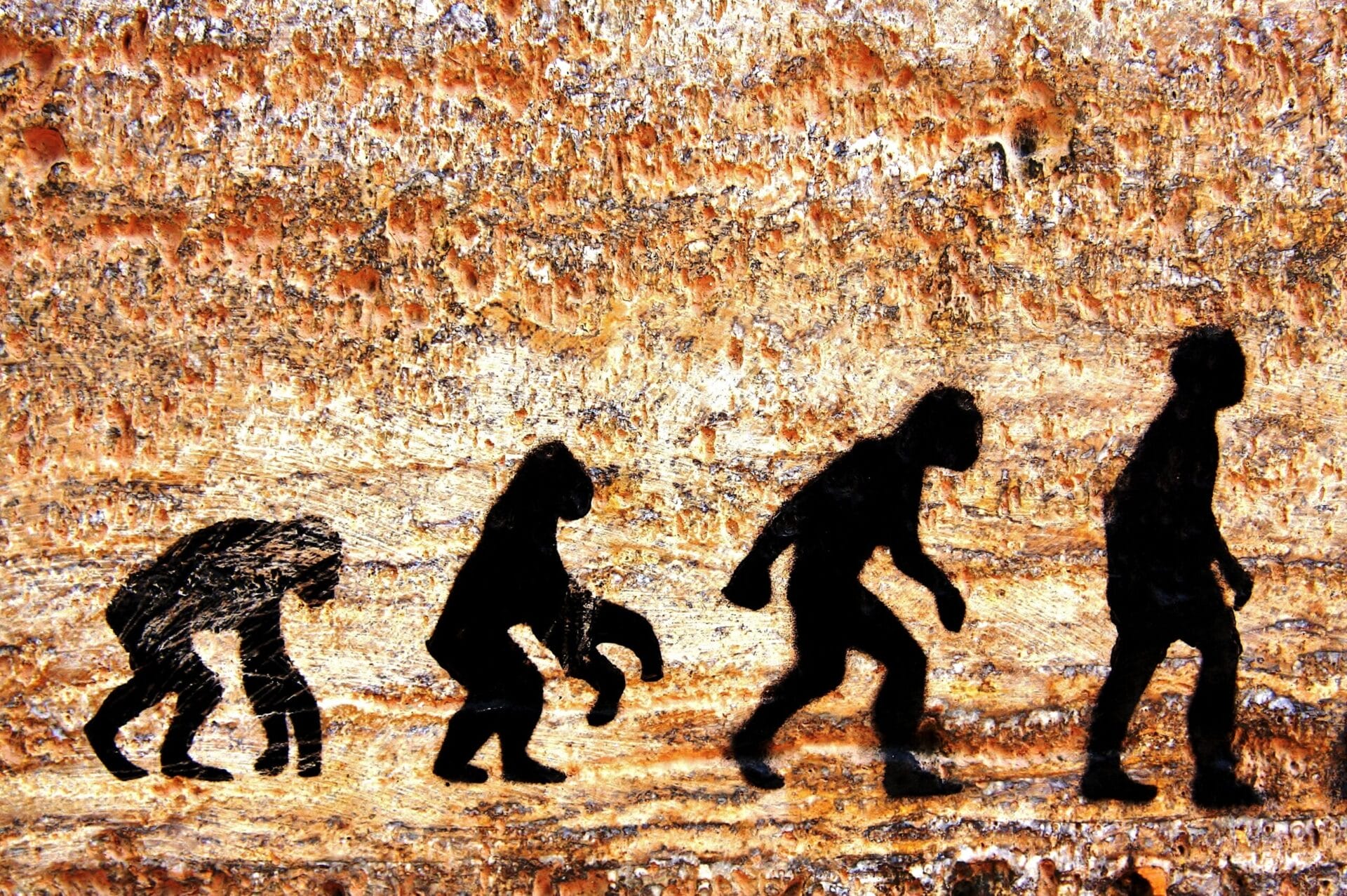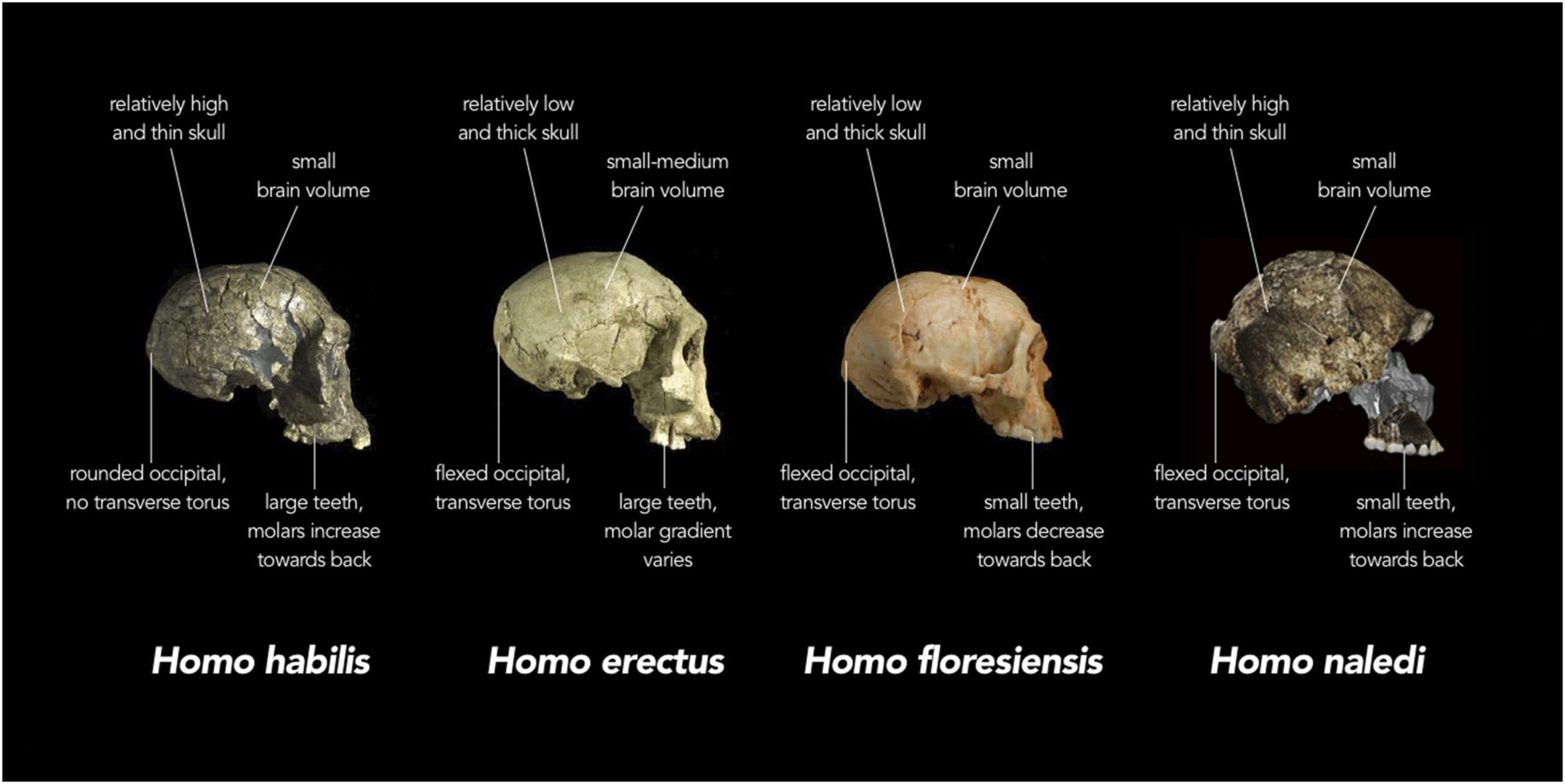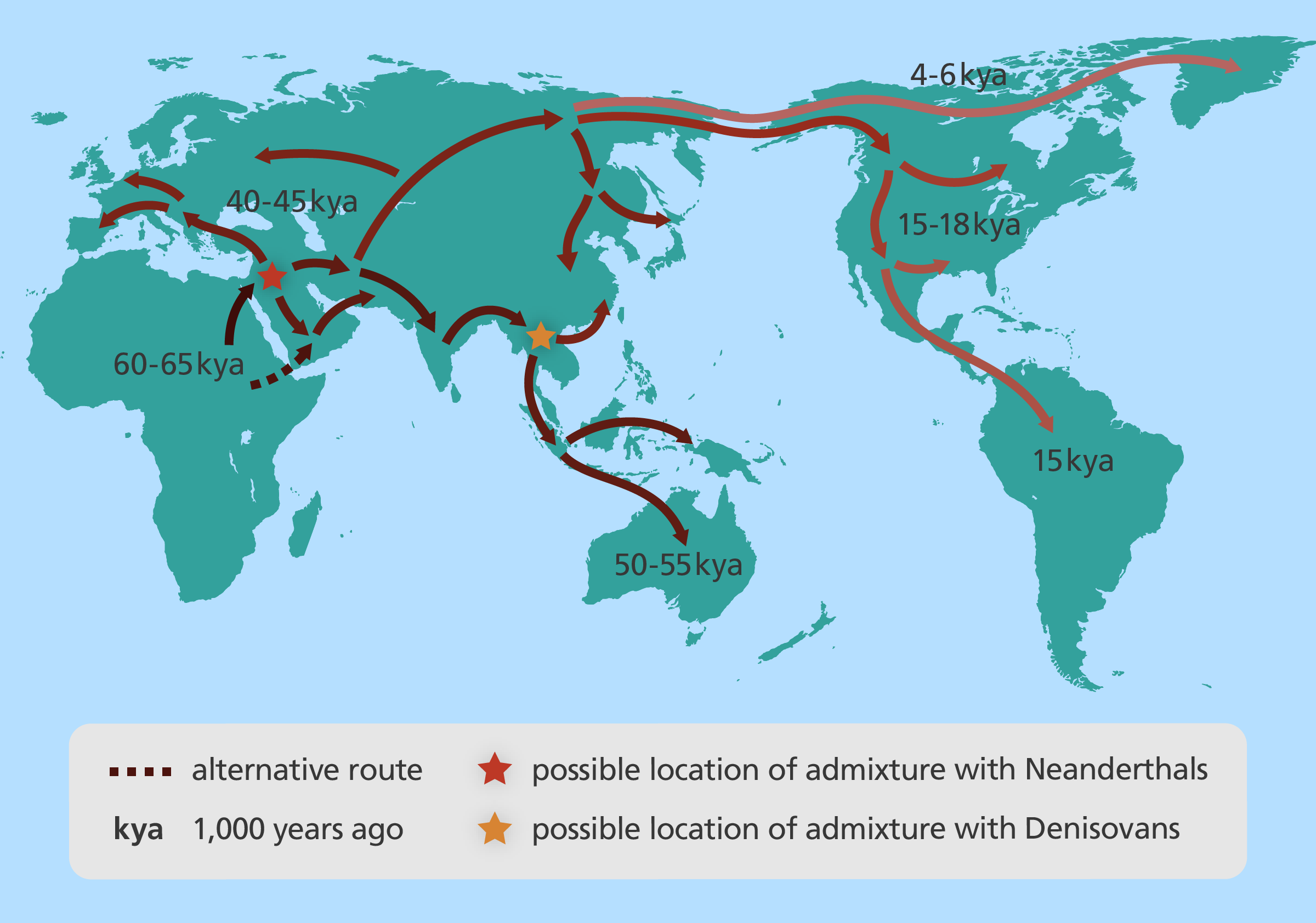Evolution of modern humans

The origin of modern humans is probably one of the most debated issues in evolutionary biology.
This is part 1 in our miniseries on human evolution, looking at how we have evolved from our early ancestors to where we are today.
Key terms
Evolution
The process by which organisms change and adapt by natural selection.
Genome
The complete set of genetic instructions required to build and maintain an organism.
Species
A group of closely-related organisms that have common physical and genetic characteristics and are able to interbreed to produce fertile offspring.
- The exact origin of modern humans, Homo sapiens, has long been a topic of debate.
- Modern humans originated in Africa within the past 200,000 years and evolved from the now extinct Homo erectus.
- Human evolution is an active area of research and current evidence supports an ‘out of Africa’ migration theory.
Where did we come from?
As modern humans, our species is Homo sapiens – meaning ‘wise man’ in Latin. We are the only surviving species of the genus Homo – but where we came from has been a topic of much debate.
Two key models have been put forward to explain the evolution of Homo sapiens: the ‘out of Africa’ model and the ‘multi-regional’ model. The ‘out of Africa’ model is currently the most widely accepted model for how and where humans evolved. It proposes that Homo sapiens evolved from the earlier species Homo erectus in Africa, before migrating across the world.
Meanwhile, the ‘multi-regional’ model proposes that our evolution took place in several places over a long period of time and that the intermingling of the various populations eventually led to the single Homo sapiens species we see today.

Current genomic evidence supports a single ‘out of Africa’ migration of modern humans.
‘Out of Africa’: what’s the evidence?
‘Mitochondrial Eve’
Our genomes – the DNA found on our chromosomes in our cells’ nuclei – are a combination of DNA inherited from both biological parents.
However, our mitochondria (the ‘powerhouses’ of our cells) have their own separate set of DNA, called mitochondrial DNA or mtDNA. This comes solely from the biological mother. This is because the egg contains large amounts of mtDNA, while the sperm contains just a tiny amount, used to power their race to the egg for fertilisation. Once a sperm and egg merge, all the sperm mitochondria and mtDNA are destroyed.
As a result, mtDNA is described as ‘matrilineal’ – and your mtDNA is almost exactly the same as your biological mother’s mtDNA, and their biological mother’s mtDNA, and so on. This mtDNA is easy to extract from the cell and so has been extensively used by biologists investigating evolution.
In support of the ‘out of Africa’ model, the origin of modern mtDNA has been tracked back to just one woman who lived in Africa around 200,000 years ago – ‘Mitochondrial Eve’. In 2019, scientists tracked Mitochondrial Eve’s ‘home town’ to the middle of the Kalahari Desert.
Mitochondrial Eve wasn’t the first or only woman on Earth at that time. Rather, she was the point from which all modern generations of humans appear to have grown. Evolutionary biologists think this is due to an evolutionary ‘bottleneck’ – which occurs when most of a species suddenly dies out, possibly due to a sudden catastrophe, bringing the species close to extinction. If Mitochondrial Eve was one of the few women to survive then this could explain why her ‘matrilineal’ mitochondrial DNA ended up being passed along so many generations.
A similar theory is true for the Y chromosome, which is passed down the patrilineal line, so that all people today with an XY chromosome can be linked back to ‘Y chromosome Adam’.
Mapping skulls
Further evidence for the ‘out of Africa’ model can be found in the size of human skulls.
After studying the genetics and skull measurements of human populations from around the world, scientists found that as you move further away from Africa, populations are less varied in their genetic makeup. This may be because human populations became smaller as they spread out from their original settlements in Africa and so genetic diversity within these populations was less.
As a result, scientists believe that modern humans could not have emerged in different places, but instead had to have come from one single origin.
In 2017, the oldest known remains and fossils of anatomically modern humans were found in Morocco, in northern Africa. The skull fossils were dated to about 300 thousand years ago and suggest that Homo sapiens spread across the entire African continent before the out-of-Africa migration.


The oldest known remains of anatomically modern humans are 300 thousand years old.
Moving out of Africa
Genetically, the billions of people of today’s world vary very little from these earlier Homo sapiens that ventured out of Africa at least 125,000 years ago. In fact, 100,000-year-old remains of modern Homo sapiens have been found in Israel.
However, evidence suggests that the first wave of humans to move out of Africa did not have too much success on their travels. As with Mitochondrial Eve’s evolutionary bottleneck, some studies predict that early humans were on the brink of extinction at times – dwindling to as few as 10,000.
The eruption of supervolcano Mount Toba in Sumatra 70,000 years ago may have led to a ‘nuclear winter’, followed by a 1,000-year ice age. This sort of event would have put immense pressure on humans. It may be that humans were only able to survive these extreme conditions through cooperating with each other. This may have led to the formation of close family groups or tribes and the development of some of the modern human behaviours we are familiar with today, such as cooperation – when you’ve finished this article, read on for part 2 in this series to learn more.

Genetically, the billions of people of today’s world vary very little from the Homo sapiens that ventured out of Africa.
Between 80,000 and 50,000 years ago, another wave of humans migrated out of Africa. These humans are likely to have been what we now think of as ‘modern’ humans, in terms of their appearance and behaviour. Due to their newly cooperative behaviour, they were more successful at surviving and covered the whole world in a relatively short period of time.
As modern humans migrated, they would have encountered earlier, primitive humans (or ‘hominids’), eventually replacing them.

Mixing with extinct humans: what’s the evidence?
The Neanderthals, or Homo neanderthalis, were an extinct species of human that was widely distributed across ice-age Europe and Western Asia. They had slightly different shaped heads to modern humans, including having a receding forehead and prominent brow ridges.
Since discovering the first Neanderthal fossil in 1856 near Düsseldorf, Germany, researchers have been striving to uncover the position of Homo neanderthalis in modern human evolution. Homo neanderthalis appeared in Europe about 250,000 years ago and spread into the Near East and Central Asia. They disappeared from the fossil record about 28,000 years ago – likely caused by competition from modern humans.
Although most research supports the ‘out of Africa’ model, some genomic research supports the multi-regional model. This second model suggests that early human or human-like species interbred with each other in different parts of the world, eventually leading to the Homo sapiens we are today.
Sequencing the Neanderthal genome
DNA can survive in bone long after an animal dies. Over time, the animal’s DNA becomes contaminated with microbes and their DNA – but it is still possible to decontaminate and extract DNA from ancient bones, up to several thousand years old.
In 2010, scientists sequenced the DNA of an entire Neanderthal genome. This was improved upon in 2013, when a more refined Neanderthal genome sequence was obtained from a 50,000-year-old Neanderthal toe bone. As with the human genome sequence, the Neanderthal genome sequence was made available online for free.
Analysing the Neanderthal genome revealed clues as to why the species went extinct. The toe bone came from someone with two X chromosomes, which were both similar in sequence. This suggests their parents were closely related. Inbreeding is generally bad for the fitness of a species, making it more susceptible to disease and illness.
If inbreeding was common in the Neanderthals, this could have led to reduced genetic variation and their eventual extinction.
Introducing the Denisovans
While investigating the Neanderthal toe bone, scientists identified a finger bone and, upon analysing its genome, identified another extinct human-like species called ‘Denisovan’ – named after the Siberian cave in which the finger was found.
Analysing the Denisovan and Neanderthal genomes suggested that these species interbred with each other. Additionally, early modern humans interbred with these now extinct species as they journeyed along coastlines and over mountains.
In favour of the ‘out of Africa’ model
When comparing genomes, modern human genomes resemble each other more than any resemble the Neanderthal genome. Additionally, some Neanderthal DNA is similar to human genomes from people of European and Asian origin – but these similarities are not seen in DNA from people of African origin.
This suggests that modern humans evolved in Africa and then expanded out into Asia and Europe, where Neanderthals lived – and where a degree of inbreeding between Neanderthals and early Homo sapiens then took place. For example, one study suggests this inbreeding took place between 37,000 and 85,000 years ago, resulting in up to around 2% of Neanderthal-derived DNA in people not of African descent.

Scientists have found nine Neanderthal genes in modern humans known to be associated with susceptibility to conditions such as type 2 diabetes.
From the past, to the future
Nowadays, many of us carry a small fraction of DNA from our archaic Neanderthal and Denisovan ancestors.
This shared DNA could have shaped our individual susceptibility to modern-day diseases or adaptation to new environments and climates. For example, scientists have found nine Neanderthal genes in living humans known to be associated with susceptibility to conditions such as type 2 diabetes, lupus and Crohn’s disease.
It has also been shown that people from Tibet have an adaptation for living at high altitudes, associated with haemoglobin concentration at different altitudes. This might have been passed down from their Denisovan ancestors.